
The following article has been transcribed by Leland Johnson from The Courier-Journal, 7 Feb 1909. It is presented here with his kind permission. The photos are scanned from microfilm which accounts for their poor quality.
Photos of Paroquet Springs Area - Taken by J. R. Buckman
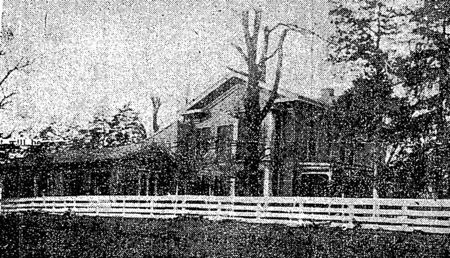
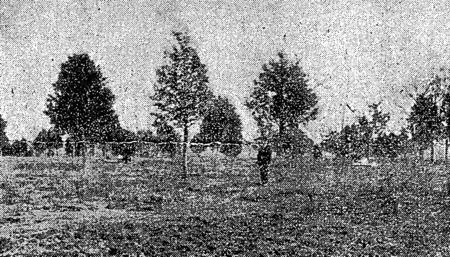
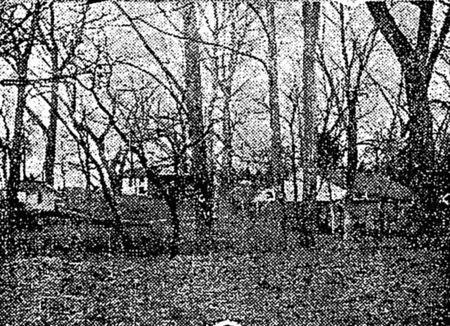
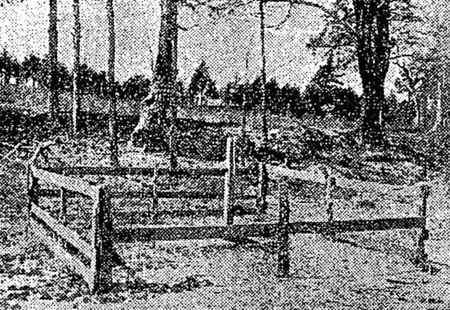
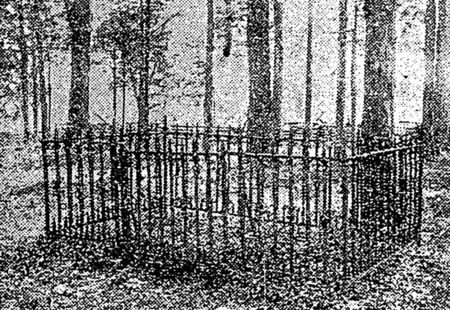
Paroquet Springs from 1826 to 1870, one of the most noted health and pleasure resorts in the Southland, is today rich in its memories of a glorious past and sadly beautiful in its quietude and loneliness. The grove with its stately cedars and sycamores and majestic beeches and oaks, is as beautiful as when the beauty and knighthood of the South made merry in its restful shade; the fine driveway can be traced almost its entire length, and the wells yet furnish their waters to all who desire them, but the magnificent hotel and cottages are gone. The clubhouse has been removed, and where strains of music once marshaled the elite of "Dixie" for the dance, the chatter of the squirrel is heard in the trees, and the wild hare rears her young undisturbed.
Paroquet Springs lies about one-half mile east of Shepherdsville between Salt River and the Mt. Washington pike. It contains about 250 acres in all, but the grove in which the Springs property was located contains about fifty or sixty acres. Until 1854 there was no railroad in Bullitt county, and all visitors came in carriages or other conveyances drawn by horses. Paroquet drew heavily from many of the Eastern States and also from the far South. Until about 1847 the Springs accommodated 800 guests, but about that date a large hotel was built and 1,000 guests could be cared for.
In 1838 James Guthrie, who in after years became president of the Louisville and Nashville railroad, became the owner of Paroquet Springs, and erected on the west side of the grove a fine residence which he occupied for a number of years. Although more than sixty-five years old the house is in splendid condition, and is shown in one of the views accompanying this article.
Before the war a fine racetrack was built at Paroquet and was the scene of some noted racing contests. It was used until about 1878 or 1879. The field is now being cultivated and all traces of the track are gone. The only remaining building which was a part of the Springs property is the billiard hall.
To the lover of nature Paroquet is an earthly paradise and always surpassingly beautiful. Whether in the winter, when snows mantle the earth and contrast with the dark green cedars, or in the spring when blooming flowers cover the grassy grove; on in the summer when the wild roses are blooming everywhere; or in the autumn when the leaves begin to fade, it is the same beautiful old Paroquet.
A visit to Paroquet Springs is not complete unless the visitor goes to the "Lone Grave," a romantic spot on the east side of the grove. The history of the lone mound hidden away among the trees and covered with its green mantle of ivy is pathetic and tragic. The writer heard the story from Judge William R. Thompson, who was a young man when the affair occurred, and who died in 1894. It is short and simple and will bear telling.
In 1834 a young man came from New York to the Springs to spend the summer, and soon after his arrival was introduced to a young woman from Mississippi, who was there with her widowed mother to spend the season. The couple seemed to have been fashioned by fate for each other. They were young, wealthy, and of aristocratic lineage, both were highly educated and gifted in music and conversation. She was a typical Southern beauty of the brunette type, of majestic figure, and her suitors were legion. He was handsome, of fine athletic form, and a social lion. It seemed to be a case of love at first sight. They became constant and inseparable companions. In the ballroom, on the river, at the musicales, or strolling beneath the boughs of the great trees, they were together unmindful of all else. Persistently and ardently he pressed his suit through the fleeting summer hours, and before the summer had waned he had won her heart.
In the fall they separated, but with the understanding that in the early winter he was to make her his wife, and take her to his Eastern home. Believing in his love and manhood, she went back to her Southern home and waited for him, but he never came, and at last, broken-hearted and disgraced, she died, after exacting from her faithful and grief-stricken old mother a promise that her body should be brought back to Paroquet Springs and buried beneath the tree under which she first met her unfaithful lover. True to her promise, her mother had the body of her unfortunate daughter conveyed to Paroquet and laid away where her last and happiest summer had been spent; and there she sleeps today beneath the mighty monarchs of the forest that keep their ceaseless vigils above her lonely tomb.
The iron fence which surrounds the grave was placed there when the grave was made about seventy-four years ago and has never been painted or cared for; but time has spared it from the touch of his destroying hand, and it is almost as good today as in 1835, when it was placed there by the faithful mother to guard the grave of her child. No message ever came back from the mother, and as time passed on the name of the unfortunate girl was forgotten. No stone is there to tell her name; but from sire to son and mother to daughter he sad story has been handed down. Nor does the story contain the name of the man who wrecked the poor girl's life. Paroquet Springs could be made a great health and pleasure resort. A fine bathing beach could be made there, and the boating is fine. Fishing is good and the wells furnish health-giving waters. For years the Paroquet Fishing Club of Louisville had a camp there and many of Louisville's most prominent men came out to recreate. If the electric car line comes this way and we get the Lincoln road [Highway 31], Paroquet Springs may become a noted resort once more.
The Guthrie home is now occupied by Mr. G. W. Simmons, who owns Paroquet. He purchased the place in 1885 from Louisville parties, and lives there in quietude with his wife and niece. He is a brother of Mrs. S. P. Myer and Messrs. W. H. And S. M. Simmons of Louisville, and is very kind to all visitors.
J R. Zimmerman
If you, the reader, have an interest in any particular part of our county history, and wish to contribute to this effort, use the form on our Contact Us page to send us your comments about this, or any Bullitt County History page. We welcome your comments and suggestions. If you feel that we have misspoken at any point, please feel free to point this out to us.
The Bullitt County History Museum, a service of the Bullitt County Genealogical Society, is located in the county courthouse at 300 South Buckman Street (Highway 61) in Shepherdsville, Kentucky. The museum, along with its research room, is open 10 a.m. to 4 p.m. Monday through Friday. Saturday appointments are available by calling 502-921-0161 during our regular weekday hours. Admission is free. The museum, as part of the Bullitt County Genealogical Society, is a 501(c)3 tax exempt organization and is classified as a 509(a)2 public charity. Contributions and bequests are deductible under section 2055, 2106, or 2522 of the Internal Revenue Code. Page last modified: 12 Sep 2024 . Page URL: bullittcountyhistory.org/bchistory/paroquetspringsarticle1909.html